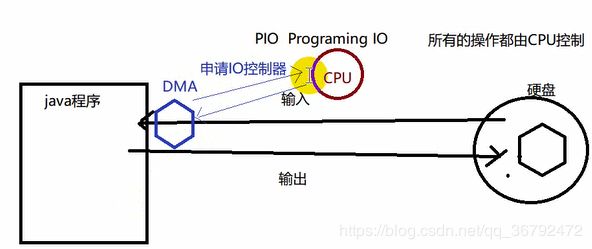NIO学习笔记
一 NIO 简介
java.nio全称Java non-blocking IO或Java New IO,是从jdk1.4 开始引入的一套新的IO api(New IO) ,为所有的原始类型(boolean类型除外)提供缓存支持的数据容器,使用它可以提供非阻塞式的高伸缩性网络。
IO操作的模式:
PIO(Programing IO): 所有的IO操作由CPU处理,CPU占用率比较高 。
DMA(Direct Memory Access):CPU把IO操作控制权交给DMA控制器,只能以固定的方式读写,CPU空闲做其他工作。
通道方式(Channel):能执行有限通道指令的IO控制器,代替CPU管理控制外设。通道有自己的指令系统,是一个协处理器,具有更强的独立处理数据输入和输出的能力。
Java NIO 由以下几个核心部分组成:
- Buffer:缓冲区
- Channel:通道
- Selector:选择器(轮询器)
NIO和普通IO有什么区别:
二、Buffer的使用
Java NIO中的Buffer用于和NIO通道进行交互。如你所知,数据是从通道读入缓冲区,从缓冲区写入到通道中的。
缓冲区本质上是一块可以写入数据,然后可以从中读取数据的内存。这块内存被包装成NIO Buffer对象,并提供了一组方法,用来方便的访问该块内存。
Java NIO里关键的Buffer实现:
- ByteBuffer
- CharBuffer
- DoubleBuffer
- FloatBuffer
- IntBuffer
- LongBuffer
- ShortBuffer
没有BooleanBuffer
2.1 Buffer的基本用法
使用Buffer读写数据一般遵循以下四个步骤:
-
创建缓冲区,写入数据到Buffer
-
调flip()方法
-
从Buffer中读取数据
-
调用clear()方法或者compact()方法
当向buffer写入数据时,buffer会记录下写了多少数据。一旦要读取数据,需要通过flip()方法将Buffer从写模式切换到读模式。在读模式下,可以读取之前写入到buffer的所有数据。
一旦读完了所有的数据,就需要清空缓冲区,让它可以再次被写入。有两种方式能清空缓冲区:调用clear()或compact()方法。clear()方法会清空整个缓冲区。compact()方法只会清除已经读过的数据。任何未读的数据都被移到缓冲区的起始处,新写入的数据将放到缓冲区未读数据的后面。
ByteBuffer是抽象类,所以不能直接用new来创建对象,可以用ByteBuffer.allocate(1024)来创建一个初始大小为1024个字节的字节缓冲区。
向缓冲区中添加字节用put
取出用get,可以取出一个字节也可以取出多个字节
最后记得清理缓冲区
public static void main(String[] args) {
//1创建缓冲区
ByteBuffer buffer=ByteBuffer.allocate(1024);
//2向缓冲区中添加内容
buffer.put("helloworld".getBytes());
//3切换为读模式
buffer.flip();
//4获取单个字节
//buffer.get();
//5获取多个字节
byte[] data=new byte[buffer.limit()];
buffer.get(data);
System.out.println(new String(data));
//6清空缓冲区
buffer.clear();
}
capacity
作为一个内存块,Buffer有一个固定的大小值,也叫“capacity”。你只能往里写capacity个byte、short、int、long、float、double、char等类型。一旦Buffer满了,需要将其清空(通过读数据或者清楚数据)才能继续往里写数据
position
当你写数据到Buffer中式,position表示当前文职。初始position值为0.当一个byte、long等数据写到Buffer后,position会向前移动到下一个可插入数据的Buffer单元。position最大可为capacity。
当读取数据时,也是从某个特定位置读。当将Buffer从写模式切换到读模式,position会被重置为0,当从Buffer的position处读取数据时,position向前移动到下一个可读的位置。
limit
在写模式下,Buffer的limit表示你最多能往Buffer里写多少数据。在写模式下,limit等于Buffer的capacity
当切换Buffer到读模式时,limit表示你最多能读到多少数据。因此,当切换Buffer到读模式时,limit会被设置为写模式下的position值。换句话说,你能读到之前写入的所有数据(limit被设置成已写数据的数量,之歌值在写模式下就是position)
Buffer的分配
想要获得一个Buffer对象首先要进行分配。每一个Buffer类都有一个allocate方法。下面时一个分配1024字节capacity的ByteBuffer的例子
ByteBuffer buf = ByteBuffer.allocate(1024);//创建间接内存,大小为1024k
ByteBuffer buf2=ByteBuffer.allocateDirect(1024);//直接缓冲区
直接缓冲区和间接缓冲区的区别
间接缓冲区:在堆中开辟,易于管理,垃圾回收器可以回收,空间有限,读写文件速度较慢
直接缓冲区:不在堆中,物理内存中开辟空间,空间比较大,读写文件速度快。缺点:不受垃圾回收器控制,创建和销毁耗性能
向Buffer中写数据
写数据到Buffer有两种方式:
·从Channel写到Buffer。
·通过Buffer的put()方法写道Buffer中
buf.put(127);
put方法有很多版本,允许你以不同的方式把数据写入到Buffer中。例如, 写到一个指定的位置,或者把一个字节数组写入到Buffer。 更多Buffer实现的细节参考JavaDoc。
flip()方法
filp()方法将Buffer从写模式切换到读模式。调用filp()方法会将position返回0,并将limit设置成之前position值
换句话说,position先现在用于标记读的位置,limit表示之前写进了多少个byte、char等——现在能读取多少个byte、char等。
从Buffer中读取数据
从Buffer中读取数据有两种方式:
·1.从Buffer读取数据到Channel
·2.使用get()方法从Buffer中读取数据。
byte aByte = buf.get();
get方法有很多版本,允许你以不同的方式从Buffer中读取数据。例如,从指定position读取,或者从Buffer中读取数据到字节数组。更多Buffer实现的细节参考JavaDoc。
rewind()方法
Buffer.rewind()将position返回0,所以你可以重读Buffer中的所有数据。limit保持不变,仍然表示能从Buffer中读取多少个数据(byte、char等)
clear()与compact()方法
清除和压缩,清除limit回到capacity位置,position回到初始位置,压缩,则是limit位置不变,未读元素放在limit之前,position回到初始位置。
一旦读完Buffer中的数据,需要让Buffer准备好再次被写入。可以通过clear()或compact()方法来完成。
如果调用的是clear()方法,position将被设回0,limit被设置成 capacity的值。换句话说,Buffer 被清空了。Buffer中的数据并未清除,只是这些标记告诉我们可以从哪里开始往Buffer里写数据。
如果Buffer中有一些未读的数据,调用clear()方法,数据将“被遗忘”,意味着不再有任何标记会告诉你哪些数据被读过,哪些还没有。
如果Buffer中仍有未读的数据,且后续还需要这些数据,但是此时想要先写些数据,那么使用compact()方法。
compact()方法将所有未读的数据拷贝到Buffer起始处。然后将position设到最后一个未读元素正后面。limit属性依然像clear()方法一样,设置成capacity。现在Buffer准备好写数据了,但是不会覆盖未读的数据。
mark()与reset()方法
通过调用Buffer.mark()方法,可以标记Buffer中的一个特定position。之后可以通过调用Buffer.reset()方法恢复到这个position。标记和回调。例如:
buffer.mark(); //添加标记
buffer.reset();//恢复到标记位置
三 Channel
基本上,所有的 IO 在NIO 中都从一个Channel 开始。Channel 有点象流。 数据可以从Channel读到Buffer中,也可以从Buffer 写到Channel中
JAVA NIO中的一些主要Channel的实现:
- FileChannel
- DatagramChannel
- SocketChannel
- ServerSocketChannel
3.1.1创建FileChannel
在使用FileChannel之前,必须先创建它。创建方式有两种:
第一种:使用一个InputStream、OutputStream或RandomAccessFile来获取一个FileChannel实例。
第二种:JDK1.7之后才能使用, FileChannel.open()方法。
StandardOpenOption是一个枚举,里面有可读,可写等方法。
//第一种
RandomAccessFile aFile = new RandomAccessFile("data/nio-data.txt", "rw");
FileChannel inChannel = aFile.getChannel();
//第二种
FileChannel inChannel = FileChannel.open(Paths.get("d:\\aaa.txt"),StandardOpenOption.READ);
3.1.2从FileChannel读取数据
调用多个read()方法之一从FileChannel中读取数据。如:
ByteBuffer buf = ByteBuffer.allocate(48);
int bytesRead = inChannel.read(buf);
首先,分配一个Buffer。从FileChannel中读取的数据将被读到Buffer中。
然后,调用FileChannel.read()方法。该方法将数据从FileChannel读取到Buffer中。read()方法返回的int值表示了有多少字节被读到了Buffer中。如果返回-1,表示到了文件末尾。
3.1.3 向FileChannel写数据
使用FileChannel.write()方法向FileChannel写数据,该方法的参数是一个Buffer。如:
String newData = "New String to write to file..." + System.currentTimeMillis();
ByteBuffer buf = ByteBuffer.allocate(48);
buf.clear();
buf.put(newData.getBytes());
buf.flip();
while(buf.hasRemaining()) {
channel.write(buf);
}
注意FileChannel.write()是在while循环中调用的。因为无法保证write()方法一次能向FileChannel写完所有字节,因此需要重复调用write()方法,直到Buffer中已经没有尚未写入通道的字节。
3.1.4 关闭FileChannel
用完FileChannel后必须将其关闭。如:
channel.close();
3.2:FileChannel操作案例
写入文件:
//1创建FileOutputStream
FileOutputStream fos=new FileOutputStream("d:\\out.txt");
//2获取通道
FileChannel outChannel = fos.getChannel();
//3创建缓冲区
ByteBuffer buffer=ByteBuffer.allocate(1024);
//4向缓冲区中放入数据
buffer.put("hello world".getBytes());
//5切换为读模式
buffer.flip();
//写入
outChannel.write(buffer);
//6关闭
outChannel.close();
System.out.println("写入完毕");
读取文件
//1创建FileInputStream
FileInputStream fis=new FileInputStream("d:\\out.txt");
//2创建通道
FileChannel inChannel = fis.getChannel();
//3创建缓冲区
ByteBuffer buffer=ByteBuffer.allocate(1024);
int len=inChannel.read(buffer);
System.out.println(len);
//4处理数据
buffer.flip();
String data=new String(buffer.array(),0,len);
System.out.println(data);
//5关闭
inChannel.close();
复制图片:
直接缓冲区的使用,可以提高读写的速度。但是直接缓冲区的创建和销毁的开销比较大,一般大文件操作或能显著提高读写性能时使用。
//1创建通道
FileChannel inChannel = FileChannel.open(Paths.get("d:\\003.jpg"),StandardOpenOption.READ);
FileChannel outChannel=FileChannel.open(Paths.get("d:\\haha.jpg"),StandardOpenOption.WRITE,StandardOpenOption.CREATE);
//2创建直接缓冲区
ByteBuffer buffer=ByteBuffer.allocate(1024);
int len=0;
//3复制
while((len=inChannel.read(buffer))>0){
buffer.flip();
outChannel.write(buffer);
buffer.clear();
}
//4关闭
inChannel.close();
outChannel.close();
System.out.println("复制完毕");
使用内存映射文件复制大文件:
内存映射文件也属于直接缓冲区
//1创建通道
FileChannel inChannel = new RandomAccessFile("d:\\01.wav", "r").getChannel();
FileChannel outChannel=new RandomAccessFile("d:\\02.wav", "rw").getChannel();
//2使用内存映射缓冲区(直接缓冲区)
MappedByteBuffer map = inChannel.map(MapMode.READ_ONLY, 0,inChannel.size());
outChannel.write(map);
//3关闭
inChannel.close();
outChannel.close();
System.out.println("复制完毕");
注意:如果文件超过2G,需要分多个文件映射。
四 Selector和非阻塞网络编程
传统网络编程
TCP ServerSocket Socket (阻塞式)
UDP DatagramSocket DatagramPacket
4.1 ServerSocketChannel、SocketChannel实现阻塞式网络编程
ServerSocketChannel式基于通道的socket监听器,等同于ServerSocket类。
SocketChannel式基于通道的客户端套接字,等同于Socket类。
实现代码:
public class Server {
public static void main(String[] args) throws IOException {
//1.创建ServerSocketChannel
ServerSocketChannel listener = ServerSocketChannel.open();
//2.绑定端口号SocketAdderss (InetAddress+端口号) 套接字地址 InetAdderess(ip地址,不包含端口号)
listener.bind(new InetSocketAddress("10.9.21.243",9999));
//3.监听,默认1阻塞
System.out.println("服务器已启动。。。");
SocketChannel socketChannel = listener.accept();
//4.读取数据
ByteBuffer buffer = ByteBuffer.allocate(1024*4);
//read阻塞,不会返回0,如果客户端关闭或结束返回-1
while (socketChannel.read(buffer)>0){
buffer.flip();//转成读取模式
String data = new String(buffer.array(),0,buffer.limit());
System.out.println(socketChannel.getRemoteAddress() + "说" + data);
buffer.clear();
}
//5.关闭
socketChannel.close();
listener.close();
}
}
public class Client {
public static void main(String[] args) throws IOException {
//1.创建客户端套接字
SocketChannel sc = SocketChannel.open(new InetSocketAddress("10.9.21.229",8888));
//2.写入
while (true) {
ByteBuffer byteBuffer = ByteBuffer.allocate(1024*4);
Scanner input = new Scanner(System.in);
String data = input.next();
byteBuffer.put(data.getBytes());
byteBuffer.flip();
sc.write(byteBuffer);
}
//如果不关闭可以一直输入数据
//sc.close();
}
}
4.2. Selector简介
要使用Selector,得向Selector注册Channel,然后调用它的select方法。这个方法会一直阻塞到某个注册的通道有事件就绪。一旦这个方法返回,线程就可以处理这些事件,事件的历字有如新连接进来,数据接收等。
选择器提供选择执行已经就绪的任务的能力,从底层来看,Selector提供了询问通道是否已经准备好执行每个I/O操作的能力。Selector允许单线程处理多个Channel。仅用单个线程来处理多个Channels的好处是,只需要更少的线程来处理通道。事实上,可以只用一个线程处理所有的通道,这样会大量减少线程之间上下文切换的开销。
选择器(Selector): Selector选择器类管理者一个被注册是通道集合的信息和它们的就绪状态。通道和选择器一起被注册,并且使用选择器来更新通道的就绪状态。
可选择通道(SelectableChannel) SelectableChannel这个抽象类提供了实现通道的可选择性所需要的公共方法。它是所有支持就绪检查的通道类的父类。因为FIleChannel类没有继承SelectableChannel因此不是可选通道,而所有socket通道都是可选择的SockerChannel和SeverSocketChannel是SelectableChannel的子类。
选择键(SelectionKey) 选择键封装了特定的通道和特定的选择器的注册关系。选择键对象被SelectableChannel.register返回并提供一个表示这种注册关系的标记。选择键包含了两个比特集(以整数的形式进行编码),选择键支持四种操作类型:
· Connect连接
· Accept 接收请求
· Read 读
· Write 写
Java中定义了四个常量来表示这四种操作类型:
SelectionKey.OP_CONNECT
SelectionKey.OP_ACCEPT
SelectionKey.OP_READ
SelectionKey.OP_WRITE
public class Server {
public static void main(String[] args) throws Exception {
//1创建ServerSocketChannel
ServerSocketChannel ssc=ServerSocketChannel.open();
//2设置为非阻塞式
ssc.configureBlocking(false);
//3绑定地址
ssc.bind(new InetSocketAddress("127.0.0.1",9999));
//4创建选择器
Selector selector=Selector.open();
//5注册选择器
ssc.register(selector,SelectionKey.OP_ACCEPT);
while(selector.select()>0){
Iterator<SelectionKey> it = selector.selectedKeys().iterator();
while(it.hasNext()){
SelectionKey selectionKey = it.next();
if(selectionKey.isAcceptable()){
SocketChannel socketChannel=ssc.accept();
socketChannel.configureBlocking(false);
socketChannel.register(selector, selectionKey.OP_READ);
}else if(selectionKey.isReadable()){
//获取SocketChannel
SocketChannel channel = (SocketChannel) selectionKey.channel();
//创建缓冲区
ByteBuffer buffer = ByteBuffer.allocate(1024);
int len = 0;
while((len = channel.read(buffer)) > 0 ){
buffer.flip();
System.out.println(new String(buffer.array(), 0, len));
buffer.clear();
}
if(len==-1){//客户端已经退出
channel.close();
}
}
it.remove();
}
}
}
}
public class Client {
public static void main(String[] args) throws Exception{
//1创建SocketChannel
SocketChannel sc=SocketChannel.open(new InetSocketAddress("127.0.0.1", 9999));
//2设置为非阻塞式
sc.configureBlocking(false);
//3创建缓冲区
ByteBuffer buffer=ByteBuffer.allocate(1024);
Scanner input=new Scanner(System.in);
while(input.hasNext()){
String s=input.nextLine();
buffer.put(s.getBytes());
buffer.flip();
sc.write(buffer);
buffer.clear();
if(s.equals("886")){
break;
}
}
//4关闭
sc.close();
}
}
总结:
1 NIO简介 Java Non-blocking IO New IO
2 和传统IO
(1) 面向流 ,面向缓冲区
(2) 阻塞, 非阻塞
(3) 无 选择器(selector)
3 NIO
Buffer
Channel
Selector
4 Buffer
ByteBuffer
CharBuffer
ShortBuffer
…
重要属性
0<=mark<=postion<=limit<=capacitiy
put();//放入数据
get();//获取数据
flip();//切换为读模式
rewind()//可以重复
mark();//做标记
reset();//返回上一个标记
clear()//清空,
compact();//清空,会保留未读取的数据
间接缓冲区: 堆中,空间不大,速度慢,jvm可以回收
直接缓冲区: 物理内存中,空间大,速度块,jvm不能回收。
5 Channel
FileChannel
5.1创建通道
InputStream OutputStream RandomAcceFile的getChannle();
FileChannel channel=FileChannel.open();
channel.read();
channel.write();
6 Selector:选择器(轮询器)(理解就可以)


